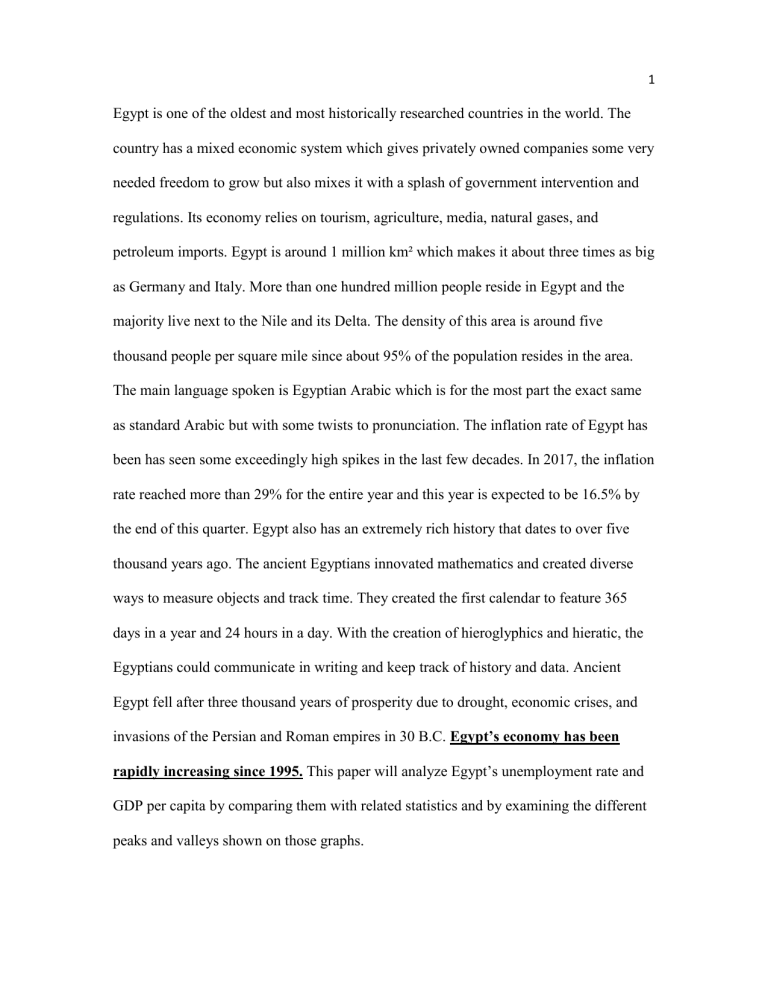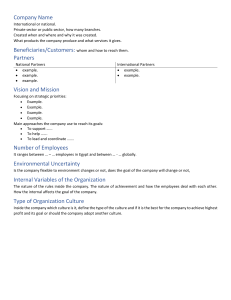
1 Egypt is one of the oldest and most historically researched countries in the world. The country has a mixed economic system which gives privately owned companies some very needed freedom to grow but also mixes it with a splash of government intervention and regulations. Its economy relies on tourism, agriculture, media, natural gases, and petroleum imports. Egypt is around 1 million km² which makes it about three times as big as Germany and Italy. More than one hundred million people reside in Egypt and the majority live next to the Nile and its Delta. The density of this area is around five thousand people per square mile since about 95% of the population resides in the area. The main language spoken is Egyptian Arabic which is for the most part the exact same as standard Arabic but with some twists to pronunciation. The inflation rate of Egypt has been has seen some exceedingly high spikes in the last few decades. In 2017, the inflation rate reached more than 29% for the entire year and this year is expected to be 16.5% by the end of this quarter. Egypt also has an extremely rich history that dates to over five thousand years ago. The ancient Egyptians innovated mathematics and created diverse ways to measure objects and track time. They created the first calendar to feature 365 days in a year and 24 hours in a day. With the creation of hieroglyphics and hieratic, the Egyptians could communicate in writing and keep track of history and data. Ancient Egypt fell after three thousand years of prosperity due to drought, economic crises, and invasions of the Persian and Roman empires in 30 B.C. Egypt’s economy has been rapidly increasing since 1995. This paper will analyze Egypt’s unemployment rate and GDP per capita by comparing them with related statistics and by examining the different peaks and valleys shown on those graphs. 2 Unemployment Egypt’s recent diversification has let to an agricultural decline in the country. Agriculture related employment has dropped by nearly 9% in the last 10 years and has gone into different sectors like industry and services. Even though the country saw a population increase of almost 20 million in that time, the number of people employed in that sector hasn’t seen a big increase. The country has seen a very large increase in its service sector in the past few decades and it has recently become the majority of Egypt’s jobs. Egypt’s unemployment rate is much higher on average than more developed countries like Canada and the United-States. Whereas Canada and the US have not seen unemployment exceeding 9.6% since 1995, Egypt has had most of its past years since then reaching over 10%. The main reasons for unemployment are overpopulation/demography of the country and the poor educational system. Most of Egypt’s population is incredibly young, over 50% of the population is aged under 25 years old. People aged from 15 to 29 account for 79.5% of all the unemployed in Egypt. 3 That combined with the average schooling time of 7.2 years makes the work force not qualified enough for many different jobs. In fact, only 40% of the unemployed population have a post high-school diploma. In 2011 Egypt’s unemployment rate skyrocketed to almost 12% and continued to be at its highest in many decades until 6 years later. The reason for this sudden spike has to due with a popular uprising that sought out to remove the former president of the country. Prolonged political instability combined with a global economic shutdown led to millions having no way to provide for their families. Unemployment started to fall back down from a reform program made by the government helped to reduce it by 2.3% in three years. 4 (Unemployment rate) 5 GDP Per Capita Egypt’s GDP per capita has increased significantly from 1995 to 2022, growing by an average of 2.3% (per capita) annually from the 1990’s to today. This is half of the 4.3% GDP annual growth however and this is due to Egypt’s rapid population growth over the same time span. GDP per capita reached almost $4000 US in 2021, up from $3600 US in 2020. Since the 1990’s, Egypt has relaxed many price controls, reduced subsidies, reduced inflation, cut taxes, and partially liberalized trade and investment. Multiple public sector reforms and privatizations have enhanced opportunities for the private sector. Even more so, since 2004, the increased pace of structural reforms helped Egypt move towards a more market-oriented economy and prompted increased foreign investment, this helped through its banking sector reforms. All of the reforms and policies created macroeconomic annual growth results that explains the above graph growth in GDP. The country’s economy also benefited from its proximity to Europe, its political stability and its increased exports coming from its improved economic reforms. As Egypt's economy 6 healed, other prominent issues like unemployment and poverty began to decline. The rapid GDP growth for Egypt has made it is one of the fastest growing economies in north Africa and the Middle East and it is now Africa’s third largest economy, accounting for 12.5% of continental GDP. Its economy has changed significantly over the last few years and has become less dependent on traditional sectors, such as agriculture, but more dependent on value added ones, such as the manufacturing sector that now represents 16% of total GDP in 2019, making it higher than Africa’s average of 11%. Construction, non-financial services, and domestic wholesale and retail trades are today largely private. This has promoted a steady increase of GDP and the continental higher than average annual growth rate the country has had over the years. 7 There is a successful diversification plan that contributes to the GDP performance of 7% increase per annum. The plan includes manly technology and telecommunications. Egypt became one of the most important start-up hubs in Africa. It generates a lot of foreign investments coming into the country. Egypt’s vision 2030 has more recently contributed and continues to this day to contribute to the high, more recent, economic growth. What is it? It is a program launched in 2016 by the Egyptian Government. It’s composed of massive government investment opportunities, such as the Hayah Karima project, the new administrative capital and local military manufacturing 8 programs. The Hayah Karima project is the social portion of Egypt Vision 2030. Its goal is to create a more decent life, more quality of life, to a portion of the population that is very poor. It really targets the population the most impoverished and vulnerable portion of the population mainly in the countryside and remote villages. The goals are to provide decent housing, quality medical and educational services, and the necessary and basic infrastructure for the most impoverished and deprived rural villages and remote areas in Egypt that are needed for a decent life. The project has 3 phases and is forecasted to reach 60 million Egyptians living in the countryside. The New Administrative Capital, Egypt's new capital city is the largest project in modern Egypt. It includes many of Egypt's planned and current mega projects under construction. These mega projects include the Iconic Tower, The Octagon, Oblisco Capitale, Capital Park, Al-Fattah Al-Aleem Mosque, Cathedral of the Nativity of Christ and the Central Business District (CBD), Olympic City, Capital International Airport. The third project relates to the country’s military needs such as ammunition, weapons, and equipment manufacturing. The intention is to meet the needs of Egyptian Armed Forces over the 10 year period (20202030). As such, the Egypt's Ministry of Military Production has developed an investment is manufacturing the equipment, weapons, ammunition etc. 9 In conclusion, Egypt is a rapidly growing country that is modernising and diversifying itself. It has seen its GDP go from sixty billion dollars (US) to four hundred billion (US) in the span of 26 years. Although the country’s GDP Per Capita is still incredibly low, it two has seen a major increase in that time span. The unemployment rate of Egypt has seen some major fluctuations over the years and remains quite high due to the young population. The country will surely continue to grow its economy and diversifying its many industrial sectors. The increasing population will keep the country’s unemployment rate high until more jobs become available. Egypt will also continue to have a fluctuating unemployment rate as it is still a developing country that has many issues with political instabilities. One of Egypt’s core issues is the fact that it has an extremely young population with a noticeably short schooling time. That issue leads into unemployment and unemployment slows down a country’s development. Investing in schooling has been proven to be the best way to ensure a country’s development and is sure to be a worthwhile investment. Another issue that the country faces is the failing agricultural industry. The diversification of sectors has left the country’s agriculture in shambles. Farmers are not getting the help they need from the government and the country is starting to pay dearly from it. The easiest solution would be to invest more money into that industry to keep it running at maximum efficiency and to ensure people will have enough food. 10 Websites and articles used: (2022). Egypt Inflation Rate. Trading Economics. https://tradingeconomics.com/egypt/inflationcpi#:~:text=Inflation%20Rate%20in%20Egypt%20averaged,statistics%2C%20economic%20calen dar%20and%20news. (2022). Egypt Inflation Rate 1960-2022. macrotrends. https://www.macrotrends.net/countries/EGY/egypt/inflation-rate-cpi (2021). Ancient Egypt. HISTORY. https://www.history.com/topics/ancient-history/ancient-egypt (2019). Egypt: Distribution of employment by economic sector from 2009 to 2019. statista. https://www.statista.com/statistics/377950/employment-by-economic-sector-in-egypt/ Roser, M. (2019). Human Development Index (HDI). Our World in Data. https://ourworldindata.org/human-development-index (2017). Unemployment in Egypt Drops to 2011 levels. ASHARQ AL-AWSAT. https://english.aawsat.com//home/article/1085816/unemployment-egypt-drops-2011levels#:~:text=Egypt's%20unemployment%20rate%20had%20worsened,quarter%20of%20the% 20following%20year. Mohamed, H. (2017). Unemployment rate falls to 11.8% in 2017. Egypt Today. https://www.egypttoday.com/Article/3/47970/Unemployment-rate-falls-to-11-8-in-2017 Enders, K. (2015). IMF Survey: Egypt: Reforms Trigger Economic Growth. International Monetary Fund. https://www.imf.org/en/News/Articles/2015/09/28/04/53/socar021308a (2014). Employment and Productivity Growth in Egypt in a Period of Structural Change 20012008. AFDB. 11 https://www.afdb.org/fileadmin/uploads/afdb/Documents/Publications/Economic_Brief__Employment_and_Productivity_Growth_in_Egypt_in_a_Period_of_Structural_Change_20012008.pdf


